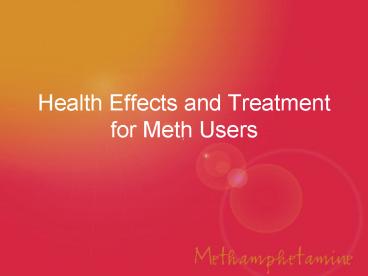Health Effects and Treatment for Meth Users PowerPoint PPT Presentation
1 / 20
Title: Health Effects and Treatment for Meth Users
1
Health Effects and Treatment for Meth Users
2
Methamphetamine Effects
- How Methamphetamine works in the brain
- Parts of the brain affected by methamphetamine
3
Methamphetamine Physiology
- Dopamine centers in the brain caudate nucleus
- Methamphetamine stimulates excess release of
dopamine - Flood the dopamine centers
4
Metabolism
- Ingested, Smoked, IV, Oral
- Half-life is variable (4-24 hrs)
- Metabolized by the liver
- Excreted in the urine
- 1/3 of meth is excreted in active form as meth
5
Short Term Effects
- Increased energy, sexual arousal, euphoria
- Decreased appetite
- Increased heart rate, abnormal rhythm, high blood
pressure, heart attack - Dizziness, seizures
- Extremely high temperature
6
Long Term Effects
- Powerful addiction unable to stop use,
tolerance, withdrawal symptoms - Neurotransmitters turned off
- Tremor, uncontrolled movements (Parkinsons
Disease) - Paranoia, hallucinations,compulsive and
aggressive behavior - Weight loss
- Insomnia, memory loss
- Persistent abnormal heart rhythms, stroke
7
Permanent Effects
- After meth is stopped
- At least 6-12 months of symptoms
- Profound depression, lack of pleasurable feelings
- Insomnia
- Psychosis, paranoia
- Permanent brain changes
- Brain scan studies show 25-80 reduction in
dopamine metabolism after gt 6 months abstinence - Davidson 2001
8
Brain Changes with Meth Use
- PET scans comparing dopamine metabolism in
control subject, abstinent meth subject (3 yrs),
and Parkinsons Disease - McCann 1998
9
Brain Changes with Meth Use
- PET scans show loss of dopamine transporters
- with meth use/addiction, and improvement
- after long-term sobriety -Volkow 2001
10
Brain Changes with Meth
- However
- Axons dont always grow back correctly
- Different parts of brain recover at different
rates - Impairment of word and picture recall persist
- Impaired ability to manipulate information
- Ignore information
- Inability to filter irrelevant information
- Studies show impairment worse at 12 weeks of
non-use than is evident in current user - Word recall gets worse, picture recall gets
better - Volkow 2001
11
Emergency Treatment Protocol
- Typical ER Protocol for Methampethamine Psychosis
- Haloperidol 5mg
- Clonazepam 1 mg
- Cogentin 1 mg
- Quiet, dimly lit room
- Restraints
- Trazadone can create stimulation should not
be used for sleep
12
Meth Withdrawal
- Depression
- Difficulty concentrating
- Severe Cravings
- Paranoia
- Exhaustion
- Confusion
13
Treatment Protocol The Matrix Model
- Originally developed specifically for stimulant
abuse and dependence. - Components include
- Individual Sessions
- Early Recovery Groups
- Relapse Prevention Groups
- Family Education Group
- 12-Step Meetings
- Social Support Groups
- Relapse Analysis
- Urine Testing
14
The Matrix Model
- Outpatient treatment for MA abuse
- Less expensive than residential or inpatient
- Easy to access
- Can be combined with job or school
- Can be delivered with varying intensities
- Is often modified to treat concurrent medical or
psychiatric disorders
15
The Matrix Model
- Phases
- Withdrawal Day 1-15
- Honeymoon Day 16-45
- The Wall Day 46 120
- Adjustment Day 120-180
- Resolution Day 180
16
The Matrix Model
- Empirically supported recommendations
- Multiple weekly sessions for at least 90-120 days
- Front loaded programs step down prior to the
Wall - Can encompass more than one level of care
- Should include strategies to engage and retain
patients to avoid premature termination
17
The Matrix Model
- Family involvement important
- More effective when at least one supportive
family member is engaged - 12-step facilitation and participation valuable
- Combination of CBT groups and self-help support
most efficacious
18
The Matrix Model
- Adaptation of Cognitive Behavioral Therapy
- Not thinking clearly
- Poor judgment
- Poor verbal recall (5 words or less)
- 20-30 minute sessions 3-4 x per week
- Emphasis on visuals handouts, painting a
picture
19
The Matrix Model
- Single, best prognostic indicator of success
- Retention
20
Summary on Research Findings
- Quality of relationship is stronger predictor of
outcomes than experience level, theoretical
orientation, or education - Clients perception of relationship better
predictor than therapists perception - No correlation between length of time and
strength of alliance - Clients usually do not report negative reactions
to clinician prior to terminating

